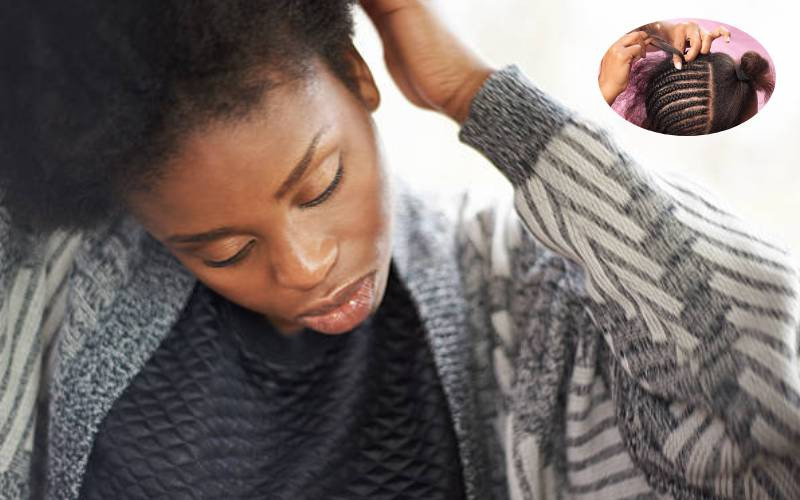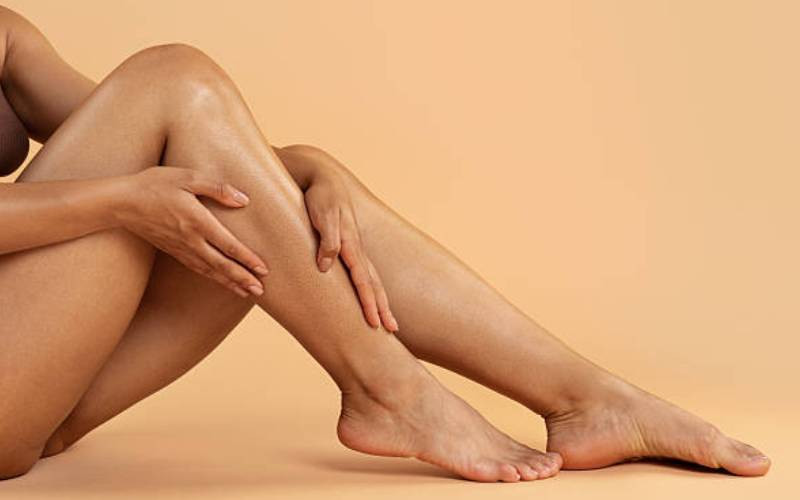
At a busy salon in Nairobi, as hairdryers buzz and stylists work swiftly with nimble fingers, a quiet struggle plays out. It’s not just about trendy hairstyles or beauty standards; it’s about hairlines receding, becoming damaged, or disappearing entirely. For many young women, this battle is one they never saw coming.
Dr Bosire Masanta, a consultant dermatologist, says traction alopecia is a form of hair loss caused by persistent and prolonged pulling on the hair, especially at the scalp’s front and sides. It commonly affects African women and is not associated with any underlying disease.
“I was born like any other child, with all body parts in place, including hair,” begins 19-year-old Annabel Wanjiru, a KMTC student in Nairobi. “But when I joined college, things changed.”
For Annabel, college represented a new world: freedom, adventure and beauty exploration. Like many young women, she wanted to express herself through her hairstyle, which meant experimenting with trends, braids and sleek looks. “I walked into a salon and requested a particular style: tight, sleek braids. But the stylist paused. She told me I didn’t have a hairline.”
Annabel was shocked. The stylist used other women nearby to illustrate what she meant. “I came to understand that I had lost hair just above my forehead,” she says. “She explained traction alopecia, hair loss caused by repeatedly pulling the hair tight in ponytails, buns, or braids, especially when combined with chemicals or heat.”
What should have been a normal salon visit shattered Annabel’s confidence. “That statement broke me. I had just joined school, trying to find myself, look good and keep up with trends. But now, I was being told I couldn’t even have the style I wanted.”
The emotional toll was immediate. Depression, low self-esteem and public scrutiny soon followed. “People started calling me names, saying I was too young to lose hair, others saying I looked old or had reached menopause,” Annabel recounts. “It hurt deeply.”
One of the most painful memories came during a traditional ‘ruracio’ (bride price) ceremony in Central Kenya, where Annabel is from. “Pretty girls were chosen to present and we were required to wear a uniform hairstyle. I was disqualified because of my missing hairline.”
- Self care: The path to being a better parent
- How to deal with sibling rivalry
- How to introduce children to budget literacy
- Modern fatherhood: Rise of the present dad
Keep Reading
Despite the ridicule, Annabel eventually began to accept her reality. “At first, I felt embarrassed. I asked close friends about it, but instead of helping, they laughed.” When she looked at her mother, she realised the condition might be hereditary, as her mother also had a receded hairline.
“I was advised to try certain oils and creams, but I feared their effects,” she says. “Some can affect the skin or make things worse. So I’ve never used any.” Today, she confidently chooses styles that hide the hair loss without causing more damage. “I prefer braids that aren’t tight, or sometimes wear caps. I don’t like wigs; they’re not comfortable for me.”
Jackline Gekonyo, 31, a mother of two from Murang’a County, shares a similar experience. Jackline’s hair loss began after childbirth in 2018.
“At that time, I was still young, excited to try different hairstyles like my friends. But while breastfeeding, people started noticing I had lost my hairline,” she recalls. “They asked whether I had used chemicals, but I hadn’t. The hair loss just happened.”
Depression and stigma quickly followed. “I used to be outspoken, but I became quiet. I stayed indoors, hiding. Even when I had to go out, I wore scarves to cover my head.”
The emotional toll deepened when people began associating her hair loss with illness, especially HIV/AIDS. “That assumption really hurt. People gave all sorts of recommendations, creams, chemicals, but I feared side effects and never used any of them.”
Today, Jackline manages the condition with dreadlocks styled to cover the missing hairline. “I know many who shaved off their hair entirely due to this condition, but I didn’t. I’m confident now. Nobody can call me ‘kipara’ (baldy) and bring me down.”
At Rongo University, 21-year-old Miriam Sophia from Busia County knows this struggle all too well. Her traction alopecia became evident when she joined university.
“In high school, I used to shave my hair, so I never noticed. But once I started university, I realised my hairline was gone. My friends changed hairstyles every week, while I couldn’t. I only had one or two that worked.”
The psychological impact was severe. “People made jokes, calling me names like ‘kipara ngoto.’ I felt ugly, rejected, and unwanted. I tried to use creams that promised hair growth, and initially, I thought they worked, but then I developed pimples and skin irritation. So I stopped.”
Sophia says she has accepted her condition. “If you try to bully me now, you’re wasting your time. I’m proud of who I am.”
Her message to others: “Don’t feel less beautiful because of your hairline. You didn’t choose this. It’s not a disease; it’s just something that happens.”
Salonists like Mary Wangari see these struggles daily. “Girls come in asking for styles that depend on edges they don’t have. I have to gently explain we can’t do it. There’s no grip, no anchor,” she says.
Mary offers alternative options: soft crochets, natural puffs, or protective styles. But she admits it’s tough convincing clients when trendy styles are the norm. “Some take the feedback well; others feel crushed.”
She educates her clients on causes: tight braids, glue, constant pulling, heat, and lack of scalp care. “Postpartum women are also at risk. Hair loss can also be stress-related.”
Mary recommends natural oils like castor and coconut, scalp massages, and spacing out styling sessions. “Our hairlines may be small, but for many girls, they carry our confidence.”
According to research in South Africa, traction alopecia affects up to 31.7 per cent of adult women and up to 21.7 per cent of children aged 6 to 15.
A Boston University study of 6,000 African-descended women found 48 per cent had experienced hair loss on the crown or top of the head, mostly due to traction alopecia.
In Kenya, the Alopecia Therapeutics Market was valued at approximately $6M (Sh780M) in 2022 and is projected to reach $11M (Sh1.43B) by 2030, driven by the rising prevalence of hair loss.
Dr. Masanta explains that traction alopecia results from mechanical damage to the follicle. Tension, combined with chemical or heat treatments, weakens the hair. While early-stage alopecia is reversible with treatment, late-stage cases involving scarring require surgical intervention.
 The Standard Group Plc is a multi-media organization with investments in media
platforms spanning newspaper print
operations, television, radio broadcasting, digital and online services. The
Standard Group is recognized as a
leading multi-media house in Kenya with a key influence in matters of national
and international interest.
The Standard Group Plc is a multi-media organization with investments in media
platforms spanning newspaper print
operations, television, radio broadcasting, digital and online services. The
Standard Group is recognized as a
leading multi-media house in Kenya with a key influence in matters of national
and international interest.










